Environmental Factors Influencing the Sustenance of the Camel Milk Value Chain in Isiolo County, Northern Kenya
Abstract
:1. Introduction
Background
2. Literature Review
3. Methodology
3.1. Background of the Study Area
3.2. Data Collection Method
3.3. Data Analyses
4. Results
4.1. Internal Environmental Factors Influencing the Sustenance of the Camel Milk Value Chain in Isiolo County, Northern Kenya
4.1.1. Categories of Livestock-Based Value Chains in Isiolo County, Northern Kenya
4.1.2. Occupational Categories of the Micro Players Involved in Camel Milk Value Chain in Isiolo County
4.1.3. Land Use System
4.2. External Environmental Factors Influencing the Sustenance of the Camel Milk Value Chain in Isiolo County, Northern Kenya
4.2.1. Rainfall Variability and Its Effect on Camel Milk Value Chain in Isiolo County
4.2.2. An Assessment of Rainfall Variability and Vegetation Cover Index and Its Implications on Camel Milk Value Chain for Isiolo County (2002–2020)
5. Discussion of Results
5.1. Contribution of Camel Milk Value Chain in Relation to Other Livestock-Based Value Chains
5.2. Climatic Variability, Seasonality and Drought Trends
6. Conclusions
Towards a Sustainable Camel Milk Value Chain in Isiolo County
Author Contributions
Funding
Institutional Review Board Statement
Informed Consent Statement
Acknowledgments
Conflicts of Interest
References
- FAOSTAT. World Camel Population. 2020. Available online: https://pastoralismjournal.springeropen.com (accessed on 25 September 2021).
- Nato, S.M.; Matofari, J.F.; Bebe, B.O.; Huelsebusch, C. Effect of predisposing factors on microbial loads in camel milk along the pastoral dairy value chain in Kenya. Pastoralism 2018, 8, 16. [Google Scholar] [CrossRef]
- Odongo, N.O.; Lamuka, P.O.; Abong, G.O.; Matofari, J.W.; Abbey, K.A. Physiochemical and microbiological post-harvest losses of camel milk along the camel milk value chain in Isiolo, Kenya. Curr. Res. Nutr. Food Sci. 2016, 4, 80–89. [Google Scholar] [CrossRef]
- Herrero, M.; Thornton, P.K. Livestock and global change: Emerging issues for sustainable food systems. Proc. Natl. Acad. Sci. USA 2013, 110, 20878–20881. [Google Scholar] [CrossRef] [PubMed] [Green Version]
- Luseno, W.K.; McPeak, J.G.; Barrett, C.B.; Little, P.D.; Gebru, G. Assessing the value of climate forecast information for pastoralists: Evidence from Southern Ethiopia and Northern Kenya. World Dev. 2003, 31, 1477–1494. [Google Scholar] [CrossRef] [Green Version]
- Behnke, R.; Muthami, D. The contribution of livestock to the Kenyan economy. In IGAD Livestock Policy Initiative Working; Intergovernmental Authority on Development Livestock Policy Initiative: Addis Ababa, Ethiopia, 2011; pp. 3–11. [Google Scholar]
- FAO. Developing Sustainable Food Value Chains: Guiding Principles; FAO: Rome, Italy, 2014; ISBN 978-92-5-108481-6. [Google Scholar]
- Downie, K. A Review of Good Practice and Lessons Learned in Programming for ASAL Populations in the Horn of Africa; UNICEF ESARO: Nairobi, Kenya, 2011. [Google Scholar]
- Ndiritu, S.W. Beef value chain analysis and climate change adaptation and investment options in the semi-arid lands of Northern Kenya. J. Arid. Environ. 2020, 181, 104216. [Google Scholar] [CrossRef]
- Government of Kenya (GoK). Dairy Industry Act, Revised Edition 2012 [1984]; Chapter 336; Kenya Government: Nairobi, Kenya, 2017. Available online: https://www.ecolex.org/details/legislation/dairy-industry-act-cap-336-lex-faoc063519/ (accessed on 18 June 2019).
- Government of Kenya (GoK). National Policy for the Sustainable Development of Northern Kenya and Other Arid Lands (2012); Kenya Government: Nairobi, Kenya, 2012. Available online: https://repository.kippra.or.ke/handle/123456789/1020/ (accessed on 4 August 2018).
- Willet, W.; Rockstrom, J.; Loken, B.; Springmann, M.; Lang, T.; Vermeulen, S. Food in the Anthropocene: The EAT-Lancet Commission on healthy diets from sustainable food systems. Lancet 2019, 393, 447–492. [Google Scholar] [CrossRef]
- Noor, I.M.; Guliye, A.Y.; Tariq, M.; Bebe, B.O. Assessment of camel and camel milk marketing practices in an emerging peri-urban production system in Isiolo County, Kenya. Pastor. Policy Pract. 2013, 3, 28. [Google Scholar] [CrossRef] [Green Version]
- Kenya National Bureau of Statistics (KNBS). 2019 Kenya Population and Housing Census: Distribution of Livestock Population by Type, Fish Ponds and Fish Cages by County and Sub County. 2020. Available online: https://open.africa/dataset/2019-kenya-population-and-housing-census/resource/bf994988-4fe3-4443-bace-6513f35c44ed (accessed on 15 March 2021).
- Government of Kenya (GoK). The County Integrated Development Plan (CIDP); GOK/Government of Kenya: Isiolo County, Kenya, 2018.
- Government of Kenya (GoK). Ending Drought Emergencies—Common Programme Framework. National Drought Management Authority, Ministry of Devolution and Planning; Government of Kenya (GoK): Nairobi, Kenya, 2015. Available online: http://www.ndma.go.ke/index.php/resource-center/category/43-ending-drought-emergencies (accessed on 25 October 2019).
- Koech, G.; Makokha, G.O.; Mundia, C.N. Climate change vulnerability assessment using a GIS modeling approach in ASAL ecosystem: A case study of Upper Ewaso Nyiro basin, Kenya. Model. Earth Syst. Environ. 2020, 6, 479–498. [Google Scholar] [CrossRef]
- Johns, T.; Powell, B.; Maundu, P.; Eyzaguirre, P.B. Agricultural Biodiversity as a link between traditional food system and contemporary development, social integrity and ecological health. J. Sci. Food Agric. 2013, 93, 3433–3442. [Google Scholar] [CrossRef] [PubMed]
- McMichael, P. Food system sustainability; Questions of environmental governance in the new world (dis)order. Glob. Environ. Chang. 2011, 21, 804812. [Google Scholar] [CrossRef]
- Sabala, P.M. Conflict, Environmental Security, and Governance, among Pastoralists in Kenya: A Case Study of the Turkana Community. 2013. Available online: http://erepository.uonbi.ac.ke/handle/11295/2/discover?rpp=10&etal=0...2of311/22/2021 (accessed on 15 March 2020).
- Wossen, T.; Berger, T.; Mequaninte, T.; Alamirew, B. Social network effects on the adoption of sustainable natural resource management practices in Ethiopia. Int. J. Sustain. Dev. World Ecol. 2013, 20, 477–483. [Google Scholar] [CrossRef]
- Omoyo, N.N.; Wakhungu, J.; Oteng’i, S. Effects of climate variability on maize yield in the arid and semi-arid lands of lower eastern Kenya. Agric. Food Secur. 2015, 4, 8. [Google Scholar] [CrossRef] [Green Version]
- Harison, K.; Mark, B.; Imwati, A. Spatial Variability of Malnutrition and Predictions Based on Climate Change and Other Causal Factors: A Case Study of North Rift ASAL Counties of Kenya. J. Earth Sci. Clim. Chang. 2017, 8, 2. [Google Scholar] [CrossRef] [Green Version]
- Ostrom, E. A General Framework for Analyzing Sustainability of Social-Ecological Systems. Science 2009, 325, 419–422. [Google Scholar] [CrossRef] [PubMed]
- Gaur, M.K.; Squires, V.R. (Eds.) Climate Variability Impacts on Land Use and Livelihoods in Drylands; Springer International Publishing: New York, NY, USA, 2018. [Google Scholar] [CrossRef]
- Miller, M.; Anderson, M.; Francis, C.A.; Kruger, C.; Barford, C.; Park, J.; McCrown, B.H. Critical research needs for successful food systems adaptation to climate change. J. Agric. Food Syst. Community Dev. 2013, 3, 161–175. [Google Scholar] [CrossRef] [Green Version]
- McPeak, J.G.; Barrett, C.B. Differential risk exposure and stochastic poverty trap among East African pastoralists. Am. J. Agric. Econ. 2001, 83, 674–679. [Google Scholar] [CrossRef]
- Okoba, B.; Dejene, A.A.; Mallo, M. Climate shocks, perceptions and coping options in semi-arid Kenya. In Experiences of Climate Change Adaptation in Africa; Springer: Berlin/Heidelberg, Germany, 2011; pp. 167–181. [Google Scholar] [CrossRef]
- Connelly, S. Mapping Sustainable Development as a Contested Concept, Local Environment. Int. J. Justice Sustain. 2007, 12, 259–278. [Google Scholar] [CrossRef]
- Davidson, O. The development and climate nexus: The case of Sub-Saharan Africa (SSA). Clim. Policy 2011, 3, S97–S113. [Google Scholar] [CrossRef]
- Li, C.; Wei, D.; Vause, J.; Liu, J. Towards a societal scale environmental sensing network with public participation. Int. J. Sustain. Dev. World Ecol. 2013, 20, 261–266. [Google Scholar] [CrossRef]
- Thornton, P.K.; Ericksen, P.J.; Herrero, M.; Challinor, A.J. Climate variability and vulnerability to climate change: A review. Glob. Chang. Biol. 2014, 20, 3313–3328. [Google Scholar] [CrossRef]
- Machan, S.; Agwata, J.; Oguge, N. Aspects of the sustainability of the camel milk value chain and its regulatory framework in Isiolo County, Northern Kenya. J. Agric. Food Syst. Community Dev. 2022, 11, 12–14. [Google Scholar] [CrossRef]
- GoK/Government of Kenya. National Climate Change Action Plan (Kenya) 2018–2022; Ministry of Environment and Forestry: Nairobi, Kenya, 2018.

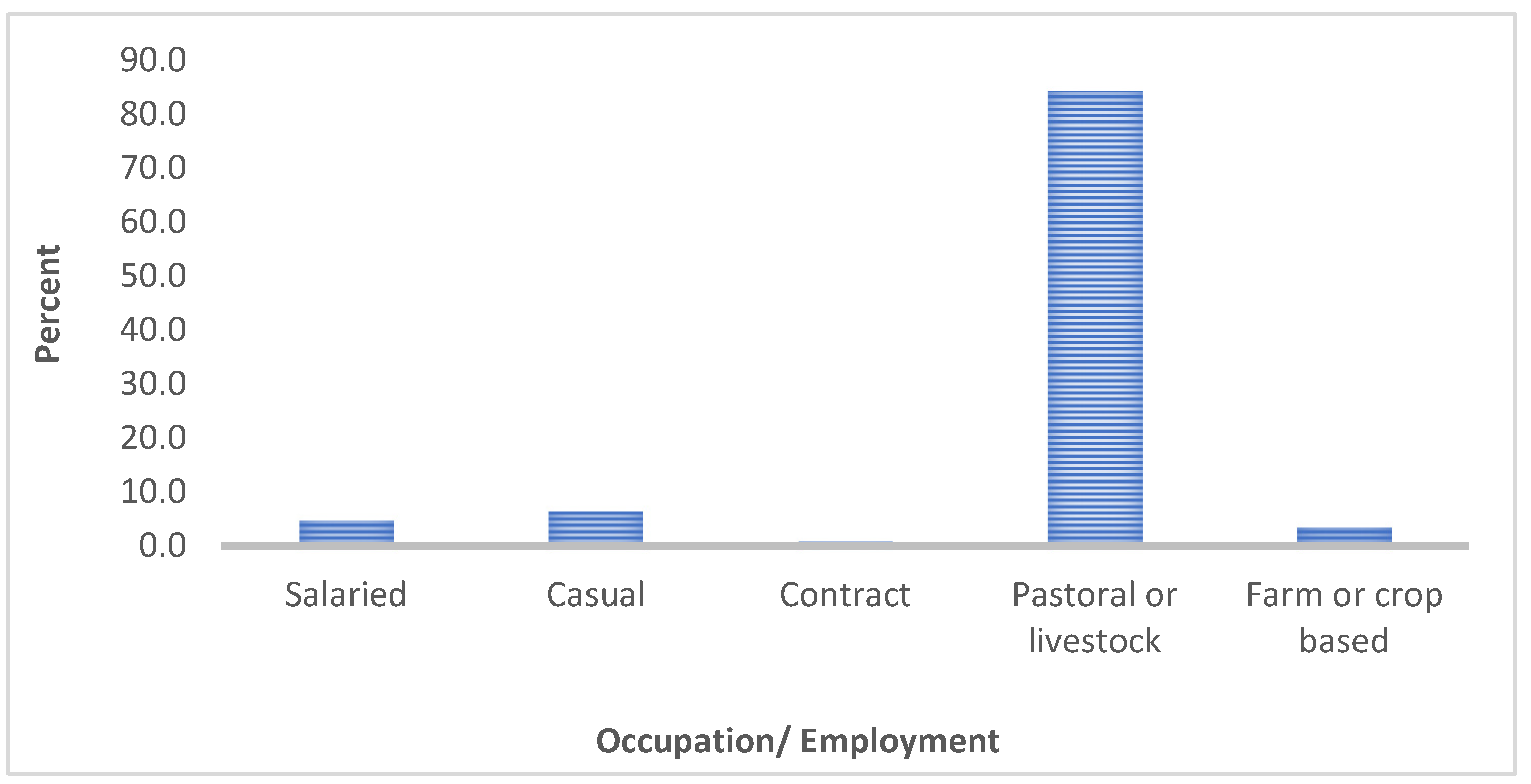
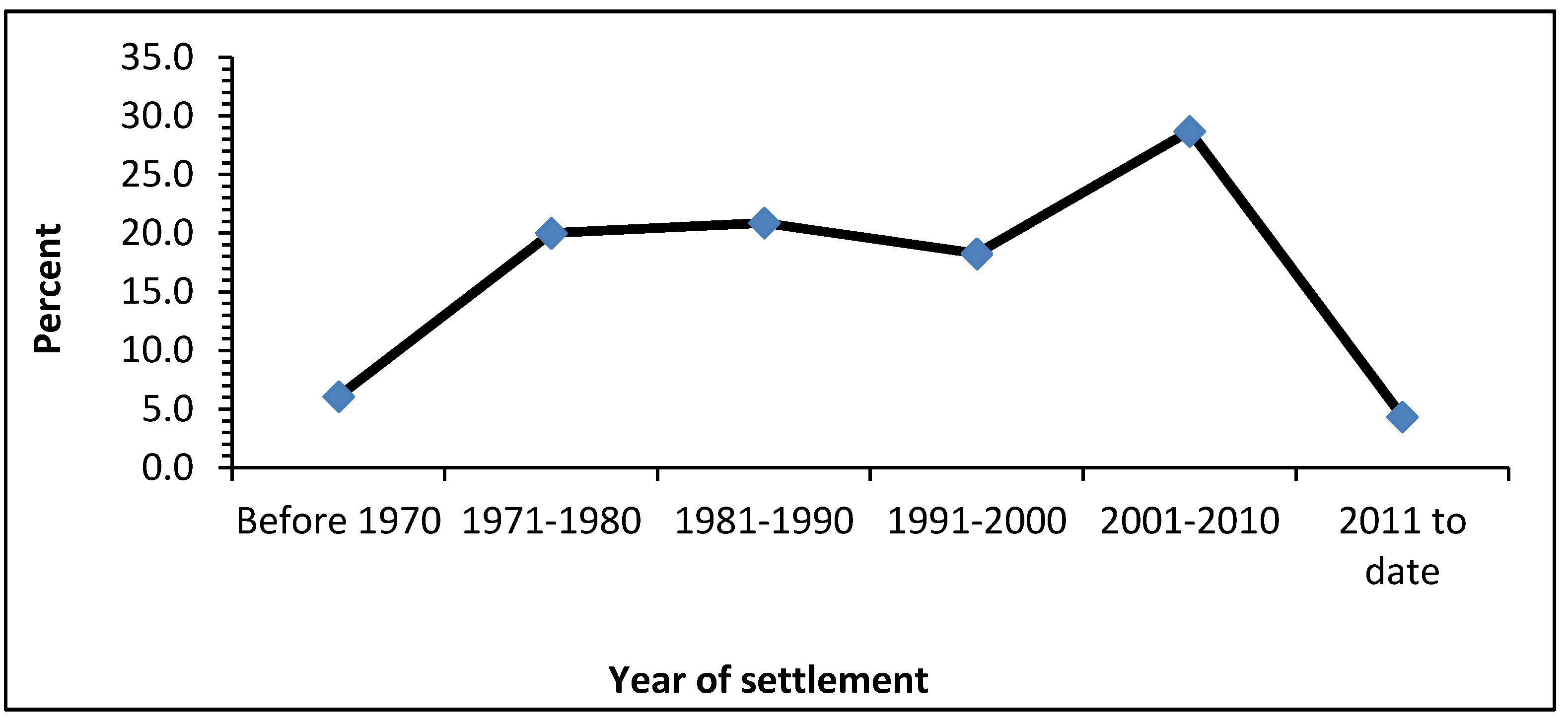

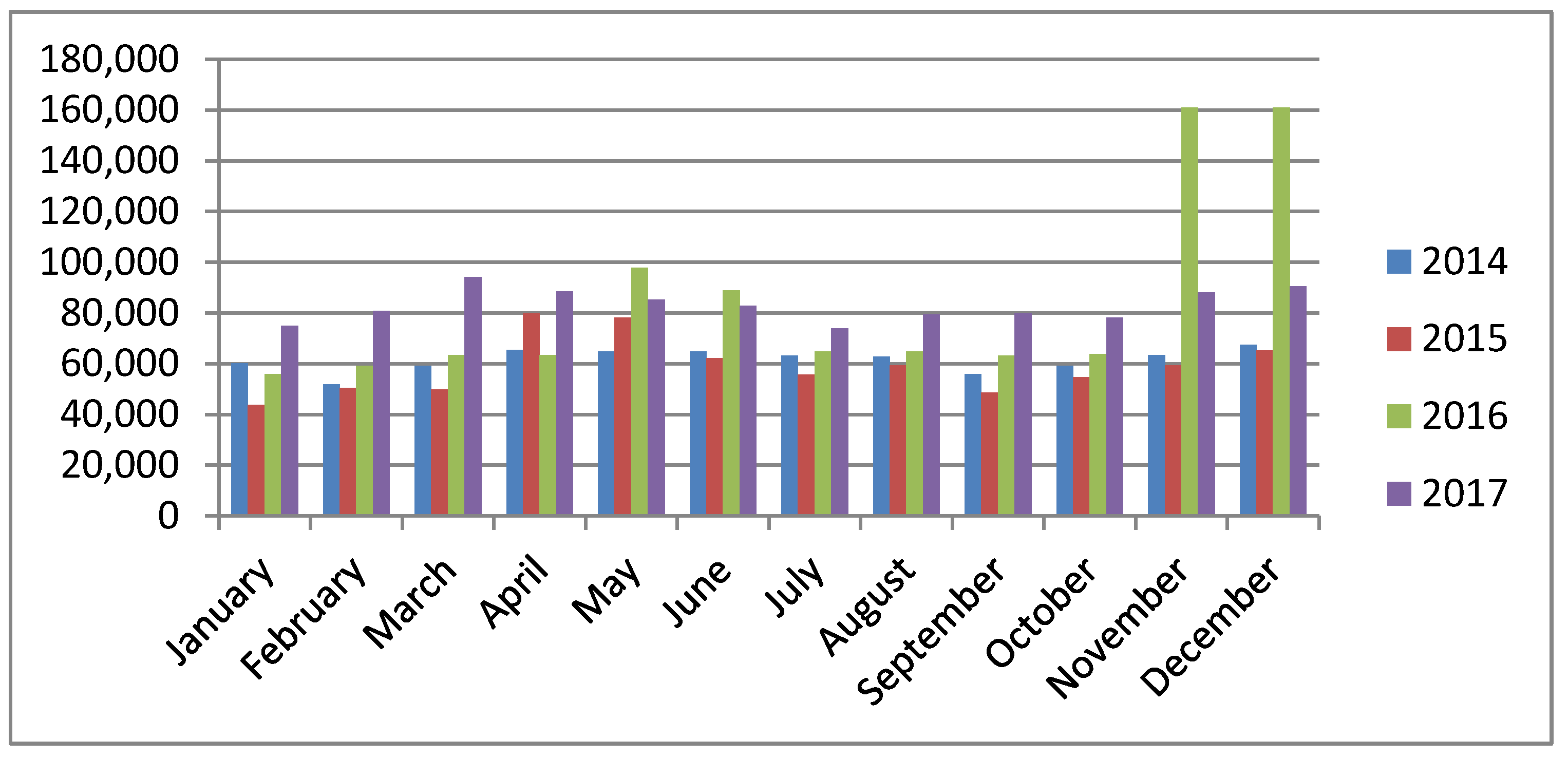
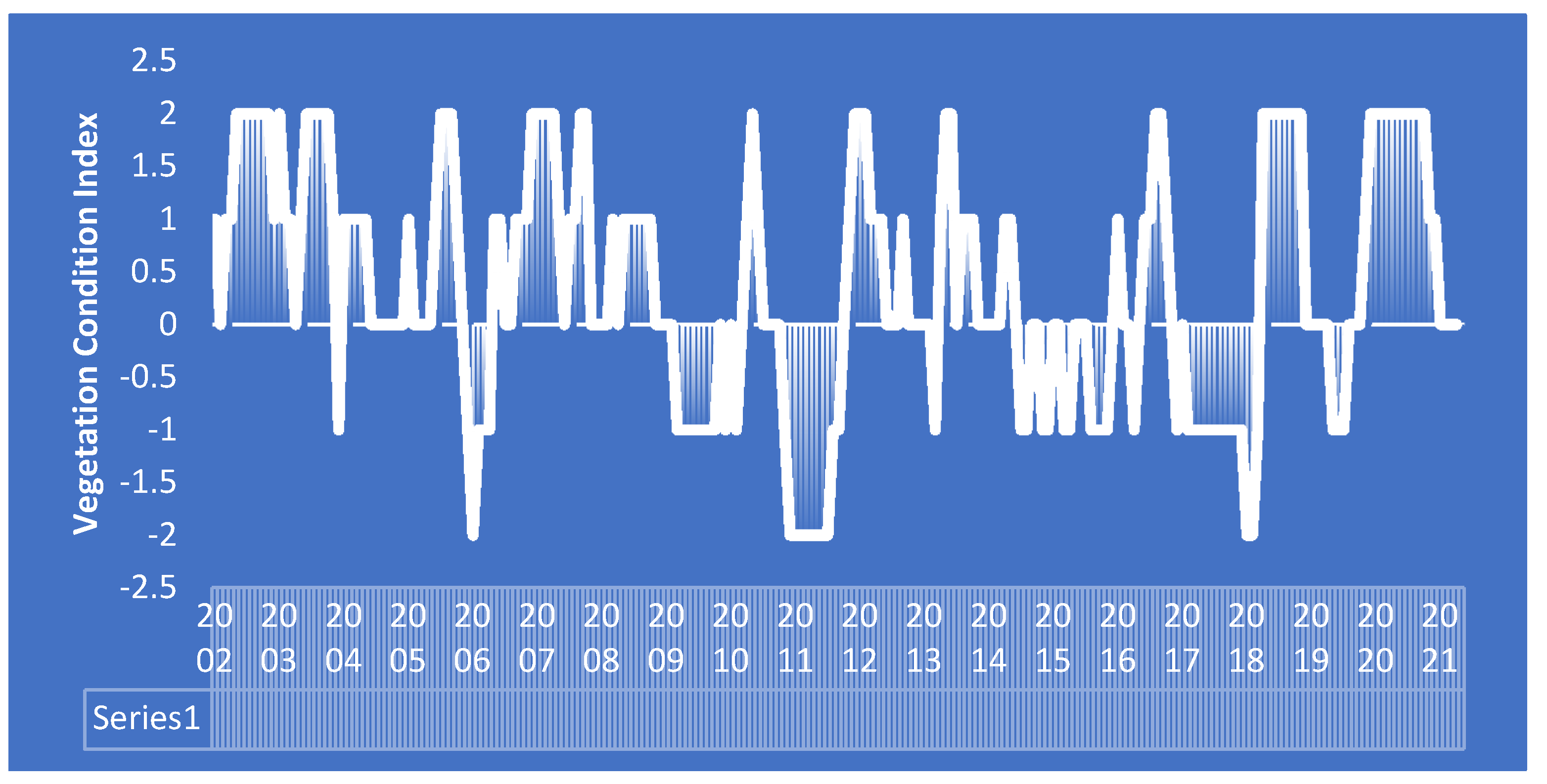
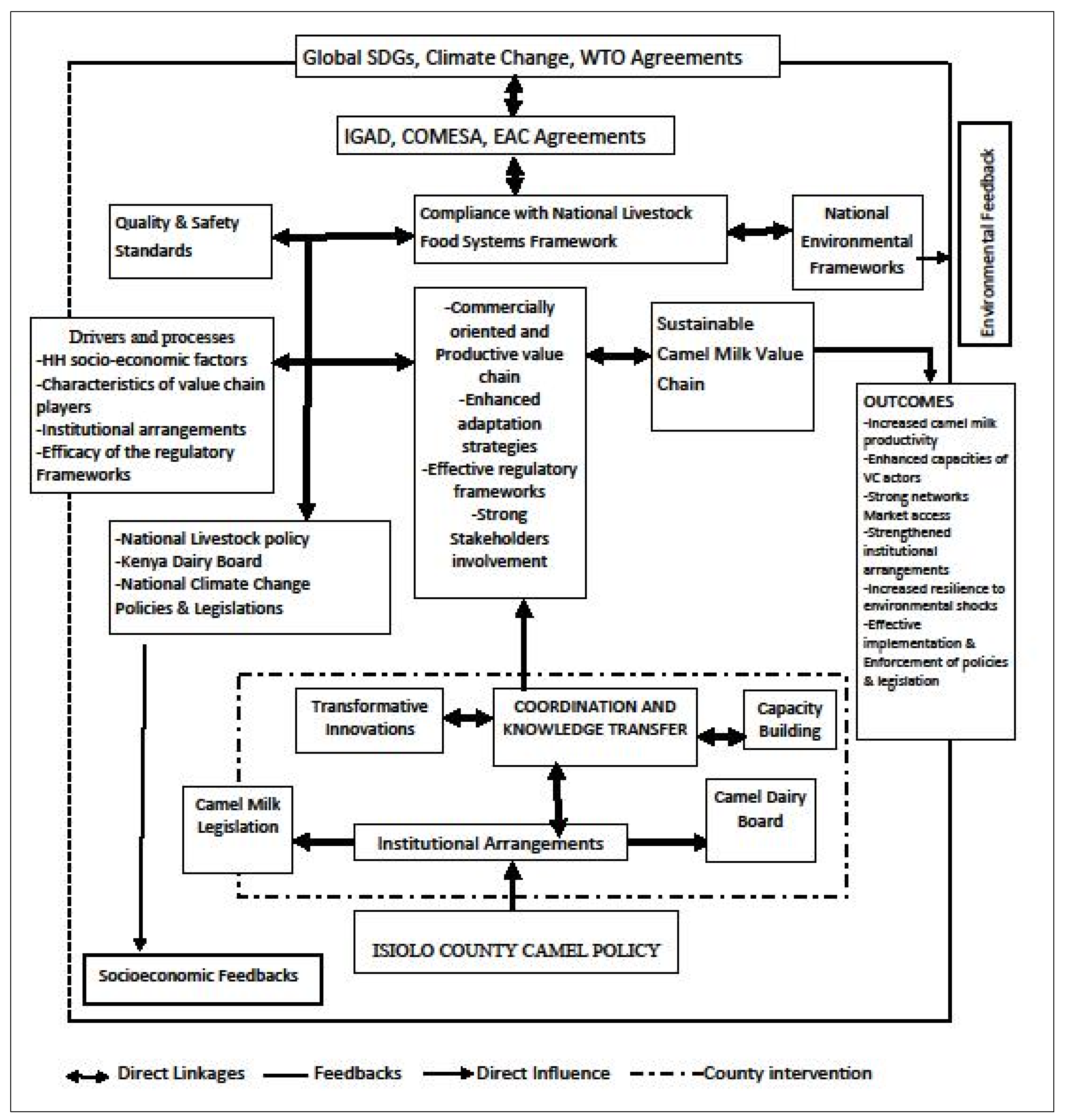
| Value Chain | Isiolo Central | Garbatulla | Merti | Totals |
|---|---|---|---|---|
| Beef | 139,293.2 | 120 | 720 | 140,133.2 |
| Meat goat | 23,940 | 5938 | 3036.4 | 32,914.4 |
| Mutton | 3448 | 14,347 | 4418.4 | 22,213.4 |
| Camel meat | 84,377.6 | 5026.4 | 0 | 89,404.0 |
| Camel milk | 259,200 | 129,600 | 100,800 | 489,600.0 |
| Poultry | 15,205.5 | 13,270.5 | 8318 | 36,794.0 |
| Hides | 1747.2 | 404.8 | 404.8 | 2556.8 |
| Skins | 1898.1 | 9111.5 | 9870.5 | 20,880.1 |
| TOTAL | 834,495.9 |
Publisher’s Note: MDPI stays neutral with regard to jurisdictional claims in published maps and institutional affiliations. |
© 2022 by the authors. Licensee MDPI, Basel, Switzerland. This article is an open access article distributed under the terms and conditions of the Creative Commons Attribution (CC BY) license (https://creativecommons.org/licenses/by/4.0/).
Share and Cite
Machan, S.N.; Agwata, J.F.; Oguge, N.O. Environmental Factors Influencing the Sustenance of the Camel Milk Value Chain in Isiolo County, Northern Kenya. Resources 2022, 11, 27. https://doi.org/10.3390/resources11030027
Machan SN, Agwata JF, Oguge NO. Environmental Factors Influencing the Sustenance of the Camel Milk Value Chain in Isiolo County, Northern Kenya. Resources. 2022; 11(3):27. https://doi.org/10.3390/resources11030027
Chicago/Turabian StyleMachan, Steve N., Jones F. Agwata, and Nicholas O. Oguge. 2022. "Environmental Factors Influencing the Sustenance of the Camel Milk Value Chain in Isiolo County, Northern Kenya" Resources 11, no. 3: 27. https://doi.org/10.3390/resources11030027
APA StyleMachan, S. N., Agwata, J. F., & Oguge, N. O. (2022). Environmental Factors Influencing the Sustenance of the Camel Milk Value Chain in Isiolo County, Northern Kenya. Resources, 11(3), 27. https://doi.org/10.3390/resources11030027





